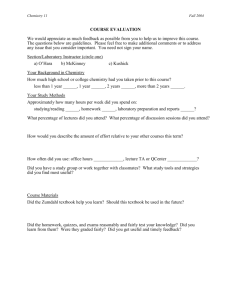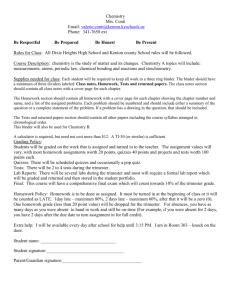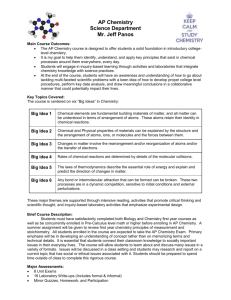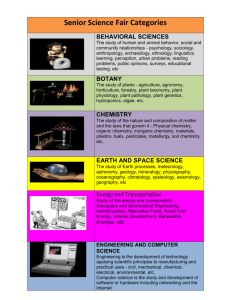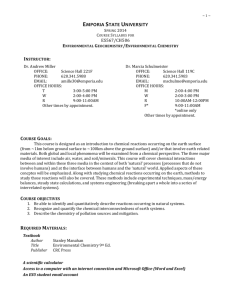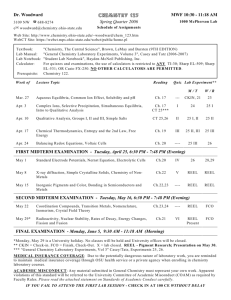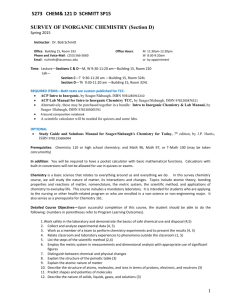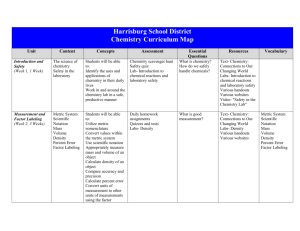Course outline CHE 1031.14
advertisement
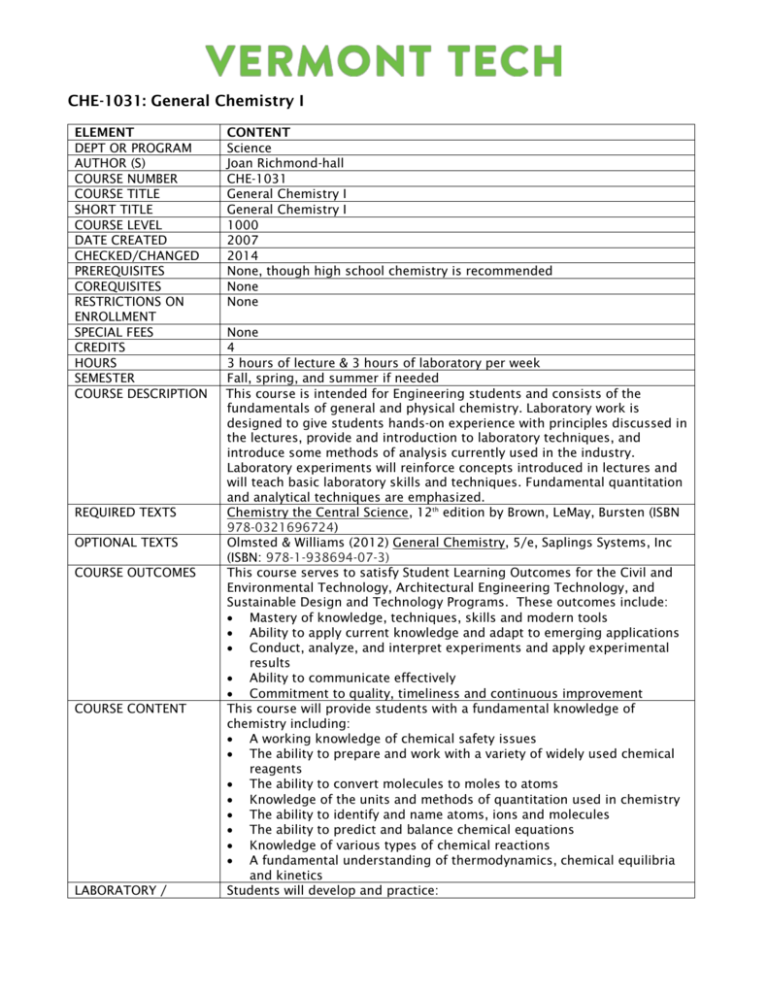
CHE-1031: General Chemistry I ELEMENT DEPT OR PROGRAM AUTHOR (S) COURSE NUMBER COURSE TITLE SHORT TITLE COURSE LEVEL DATE CREATED CHECKED/CHANGED PREREQUISITES COREQUISITES RESTRICTIONS ON ENROLLMENT SPECIAL FEES CREDITS HOURS SEMESTER COURSE DESCRIPTION REQUIRED TEXTS OPTIONAL TEXTS COURSE OUTCOMES COURSE CONTENT LABORATORY / CONTENT Science Joan Richmond-hall CHE-1031 General Chemistry I General Chemistry I 1000 2007 2014 None, though high school chemistry is recommended None None None 4 3 hours of lecture & 3 hours of laboratory per week Fall, spring, and summer if needed This course is intended for Engineering students and consists of the fundamentals of general and physical chemistry. Laboratory work is designed to give students hands-on experience with principles discussed in the lectures, provide and introduction to laboratory techniques, and introduce some methods of analysis currently used in the industry. Laboratory experiments will reinforce concepts introduced in lectures and will teach basic laboratory skills and techniques. Fundamental quantitation and analytical techniques are emphasized. Chemistry the Central Science, 12th edition by Brown, LeMay, Bursten (ISBN 978-0321696724) Olmsted & Williams (2012) General Chemistry, 5/e, Saplings Systems, Inc (ISBN: 978-1-938694-07-3) This course serves to satisfy Student Learning Outcomes for the Civil and Environmental Technology, Architectural Engineering Technology, and Sustainable Design and Technology Programs. These outcomes include: Mastery of knowledge, techniques, skills and modern tools Ability to apply current knowledge and adapt to emerging applications Conduct, analyze, and interpret experiments and apply experimental results Ability to communicate effectively Commitment to quality, timeliness and continuous improvement This course will provide students with a fundamental knowledge of chemistry including: A working knowledge of chemical safety issues The ability to prepare and work with a variety of widely used chemical reagents The ability to convert molecules to moles to atoms Knowledge of the units and methods of quantitation used in chemistry The ability to identify and name atoms, ions and molecules The ability to predict and balance chemical equations Knowledge of various types of chemical reactions A fundamental understanding of thermodynamics, chemical equilibria and kinetics Students will develop and practice: STUDIO OUTCOMES LABORATORY / STUDIO CONTENT GRADED OR P/NP SUGGESTED EVALUATION DELIVERY METHOD ROOM REQUIREMENTS AUTHOR’S NOTES An understanding of the scientific method; Knowledge of basic laboratory technique; The ability to collect data and produce results in a laboratory; The ability to use scientific notation and significant figures in calculations; The ability to write a detailed lab report, communicating findings supported by organized and analyzed data; and The ability to think critically about data produced in laboratory experimentation. Week 1 Lab safety training 2 How to think like a scientist: putting the scientific method into practice 3 Naming chemical compounds 4 Measurement, density and salinity 5 Formation of ionic compounds by acid oxidation 6 Precipitation, limiting reactants & theoretical yields 7 Acid strength & titration 8 Titration & buffering: neutralizing potential of commercial antacids 9 Electron configuration of atoms & ions 10 Lewis dot structures & molecular geometry 11 Exploration & demonstration of the ideal gas law 12 Reaction rates & redox reactions 13 Reaction kinetics: the iodine clock reaction 14 Review for the final exam Graded Student competence is determined through evaluation of: daily reading quizzes; weekly or biweekly quizzes; graded homework assignments; open-book lab quizzes and lab reports; four hourly written examinations; final cumulative exam of 3 hours Face-to-face Lecture room & Morrill 132 Chemistry Lab
